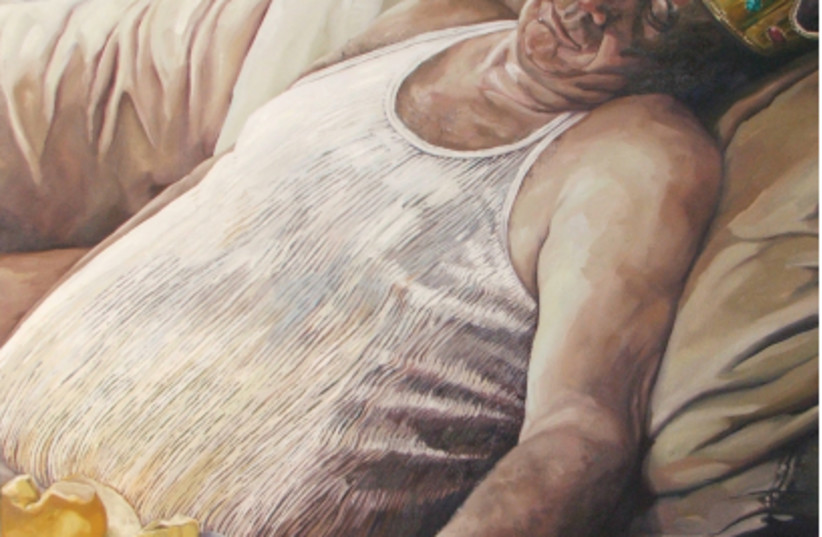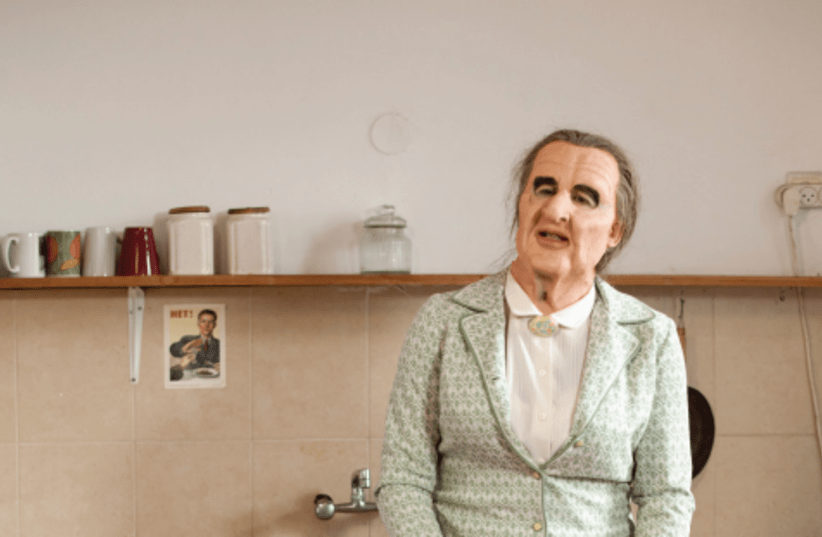‘Alpha” is a pretty good choice as far as exhibition titles go. It is concise and to the point and, when juxtaposed with the male of the human species, it conveys the idea of a socially familiar gender context in a succinct and widely understood manner.
Then again, if you make your way to the Museum on the Seam – at its history-laden and uniquely positioned premises betwixt haredi, Muslim and Christian Jerusalem – it is a fair bet you will come away with a more open and understanding approach to the way males as a whole feel and behave, with plenty to mull over.
The spread, curated by the socio-political contemporary art museum curator Shahar Shalev, under the guidance of consulting curator Dr. Shir Aloni Yaari, dips into a surprisingly broad stretch of fields, walks of life, styles, disciplines and mindsets. Take, for example, the eye-catching diptych by Jossef Krispel, a Bezalel Academy of Arts and Design graduate and current head of the Fine Arts Department. His oil painting two-parter dips into the realms of fantasy and beloved legend. Both pictures feature the instantaneously recognizable scene with the gallant and pristinely decked out Prince Charming adoringly leaning over the prostrate sleeping figure of Snow White, about to apply his life-restoring kiss. Or is he?
Judging by the painting at the left, the answer is probably in the affirmative; but according to Shalev, there is a deeper subtext to the iconic scenario.
It is quite possible that many a male, of any age, would be happy to identify with the dashing savior. Who wouldn’t want to be cast in the role of the gallant knight in shining armor alighting from his steed with much panache, and then performing the prerequisite rescue of the archetypal damsel in distress?

“That may be right,” Shalev observes, “but if you think about it, that is very limiting, too. That makes the man very one-dimensional.”
It’s an interesting point that many of us would not readily discern, having grown up with the Disney view of the way things should be, where right and wrong were clearly apportioned, with nary a gray area. While presenting the male as strong and compassionate, is that all there is to a man? Are there doubts in his mind about the way things are panning out? Is he happy with his position in society?
As you move around the exhibition, most of which is displayed on the museum’s ground floor, you get the idea that there is much more to the guy than initially meets the eye.
THE SHOW opener references the stock universal perception of the human male and the primordial image of the hunter, provider and protector.
But social and socio-political developments, including the continually gathering momentum of feminist sensibilities, have impacted substantially on that yesteryear image.
Examining the role of masculinity and gender roles in society in the 21st century
The classic role of the man as omnipotent head of the household has been up for grabs for some time with, for example, many Western countries now including the father in parenthood-leave benefits paid by the equivalent of National Insurance Institutes in the relevant country.
Then again, during the coronavirus era lockdowns, there was an alarming rise in domestic violence, generally committed by men toward their female partners. While that was mostly sparked by an unnatural situation, with families cooped up inside their own four walls for extended periods of time, the tendency to inflict abuse must have been there in the first place, with the temporary confinement exacerbating a menacing extant undercurrent.
Shalev took that, and much more, on board in addressing her curatorial role.
She points out that Alpha isn’t about men per se. Rather, it provides an artistic and sociological overview of men in these parts. Unlike the majority of the museum’s roll-outs, Alpha stuck to home-based contributors.
“The idea was to open up the category of the Israeli man,” she explains.
“That involves deconstructing and re-assembling in order to get to the contemporary masculine Israeli identity.
Of course, there is no one answer to that, and there are many strata and aspects involved.”
That is crystal clear from the collection of works by 21 local artists.
The latter was a no-brainer direction for Shalev. “There was no point in spreading outside Israel for this. That would have been over the top,” she says. Getting a handle on the current zeitgeist was also a major consideration. “All the works are from the last two decades.”
Interestingly, the exhibitors include male and female artists, with some of the women digging into the subject matter in no uncertain manner. Yael Yudkovik’s Untitled (Behind) is a striking specimen of getting to grips with the material – literally.
The pigmented inkjet print shows the shaven head of a man, from the rear. The angle and lighting serve to almost dehumanize the subject. “This work is part of a series of photographs in which the artist gathered men from local gyms around her residence and invited them to her studio. There, as Delilah did with Samson, she shaved their hair, anointed their bald heads with oil and photographed them from behind,” Shalev notes.
The result, as the exhibit wall text elucidates, “is an animalistic and erotic sculptural image, on the border of the figurative and abstract, aesthetic and pornographic.”
Shalev feels there is a coming-of-age aspect in there, too. “It is interesting that balding men increasingly actually shave off their hair rather than try to cover their pate up by all sorts of methods. The men in Yael’s project are shown in a womanly non-virile pose. This turns their gaze in a different direction. In art over the centuries, we are used to men turning women into generic women. Here, Yael has turned the tables.”
There are allusions to the macho side of men, and some decidedly unimposing depictions. Moving smoothly along the display hall wall, we encounter Vered Aharonovitch’s portrayal of her father. The oil painting does not, at first glance, appear to do the man too many favors. We see a gent, patently past his prime, dozing off in an armchair and clad in a shabby undershirt. The snooze does not appear to be planned. A plate of half-eaten fruit sits precariously on one thigh, and someone has placed a cheap golden crown on his drooping head.
The man is obviously out for the count and, to put it politely, is not showing his better profile.
However, as Shalev says, this is not the result of a prank, and there is nothing barbed about the picture. “The crown is not the real thing, with plastic gemstones in it. But for Vered, even when he is all limp and sleepy, he is always her father. The title of the work, Dad, rather than Father, amplifies the loving feel-good factor.
NATURALLY, YOU can’t have an exhibition of this sort in this part of the world without taking a look at militaristic pursuits. There are items that address the substrata of regional violence, with Caterpillars by Daniella Meroz imparting a clear sense of the futility of war and displays of macho bravado. The video shows a couple of giant sculptures, made of pink-purple polyurethane foam – not the kind of hue one automatically associates with alpha males – squaring off in the middle of nowhere. They go through the dueling foreplay motions but don’t really get down to it.
The barren primeval backdrop only serves to highlight the grotesqueness and ineffectuality of the combatants’ moves, and it is not clear whether the burlesque pas de deux is actually leading anywhere or whether there is any communication taking place.
In a very different take on the omnipresence of the military element in Israeli life, the Body Language video work by Tamir Zadok contrasts the insouciant activities of young children with the IDF obstacle courses they play in, presumably not giving a thought to the possibility that, a few years down the road, they may have to tackle the facilities in earnest. That may resonate powerfully with many a parent who may recall wishing that, by the time their newborn offspring turns 18, there will no longer be a need to serve in the army.
The fun-manly gravity equilibrium is probably portrayed in its most impressive, and laughable, form in Kings of the Hill. Yael Bartana’s seven-and-a-half-minute video dates from 2003 and captures what appears to be something of a Sisyphean scene. We see men in all manner of four-wheel drive vehicles doing their damnedest to negotiate impossibly steep and precarious sand dune slopes. The backdrop of a gently lapping azure blue Mediterranean, and their wives and children, is largely ignored. They only have one thing on their mind: taking the hill.
The cacophonic mechanized calisthenics go on interminably. Mesmerizing aesthetics notwithstanding, the temptation is to either laugh out loud, scornfully, or to tell the drivers to just give up and go home.
For Bartana the madcap, seemingly nonsensical scene is a parodied vignette of local dynamics. As the accompanying text puts it so succinctly: “Once the imagery fades, realization dawns – we are watching a social ritual heavy with the symbols and myths of power that propel Israeli society.”
We get the religious manifestation of an exclusively male action-packed domain in another video work, Dancing with Men by Oreet Ashery. In 2003, the artist dressed up as a yeshiva student and infiltrated the men-only Lag Ba’Omer celebrations at Mount Meron.
Dressed in the requisite garb – black hat, black suit and flowing tzitzit – she seamlessly plies her course through the masses of hassidic men, with nary a hint of her gender.
Although she makes it into the heart of the all-male festivities, she can never truly be part of them. As a woman, Ashery is excluded from many areas and practices of Orthodox Judaism and, posing as a haredi man, she is the antithesis of macho masculinity in the Zionist-Israeli ethos. In one more twist of the male-female crossover divide, Shahar Marcus, a male actor and puppeteer by profession, dresses up as a grotesque figure of late prime minister Golda Meir in a parody of Meir’s famed “security kitchenette” soirees. The video shows
“Meir” making a cake while offloading a stream of political dogma and her ideas about how to achieve lasting regional peace.
Her domestic performance contrasts sharply with the militaristic verbal content, and the clash between the traditional womanly role and her political standing in a male-dominated field places a heavy question mark on her efforts to achieve parity, let alone leadership. In Marcus’s grotesque play, masculinity is viewed not as the exclusive territory of men but as a set of performative values and gestures embodied in the character of Golda Meir, whom David Ben-Gurion once described as “the only man in my cabinet.”
The exhibition zeitgeist context is tweaked just a mite by the reference to Belgian-Jewish surrealist painter Justine Frank, in Frank’s Guild, 1933.” In fact,
Frank is a fictional character, created by 59-year-old Roee Rosen, as an outcast in the Zionist society of 1930s Tel Aviv. Rosen portrays Frank as a quartet of characters that run the gamut from a haredi man to an androgynous figure, a rabbi and an executioner. The identity-fluid group is designed to impart an eclectic image of Judaism and what comprises the Jewish man.
Drama, comedy, politics, intimacy and social critique combine to make Alpha an alluring and evocative exhibition.
The exhibition was inspired by the Masculinities in Israel research and film project, which was initiated and produced by the Heinrich Boell Foundation, and launched at Tel Aviv Cinematheque.
“Alpha” closes on February 28, 2023. For more information, see mots.org.il/home-hb. To view the entire project visit: https://il.boell.org/en/masculinities-israel












